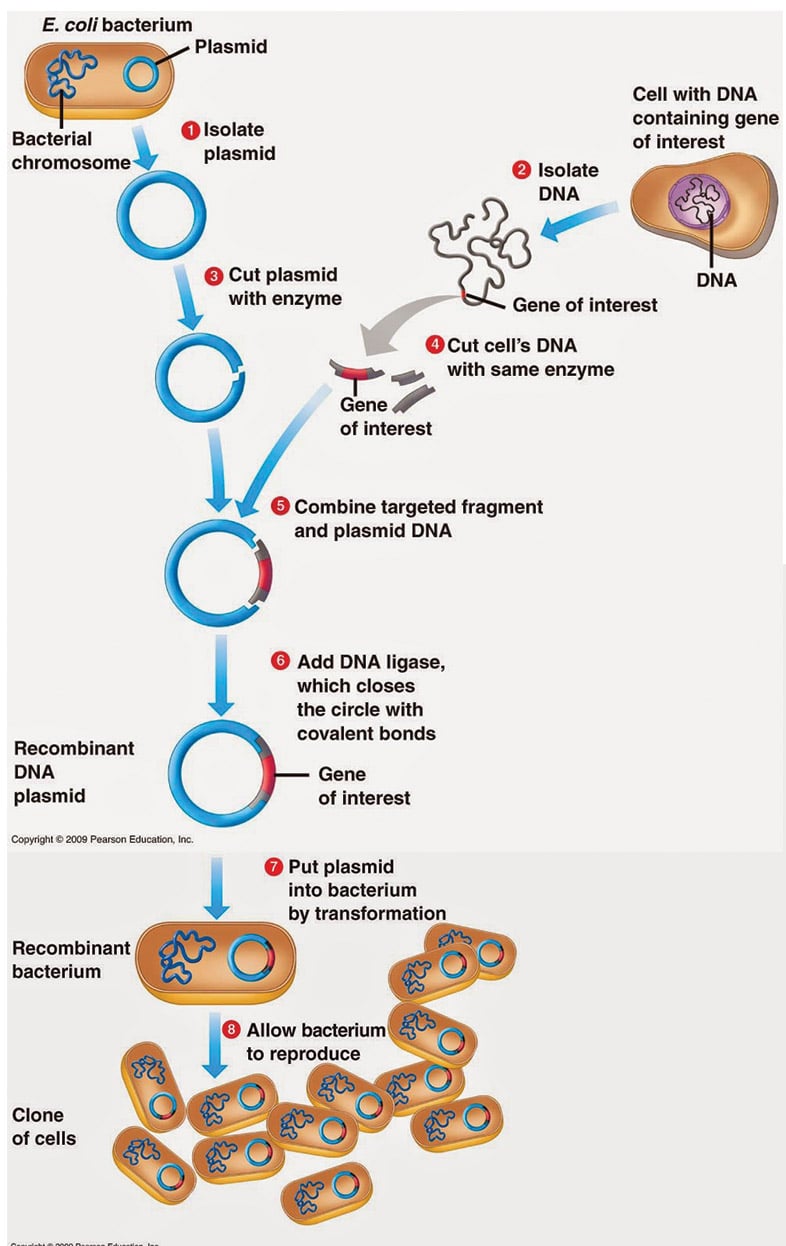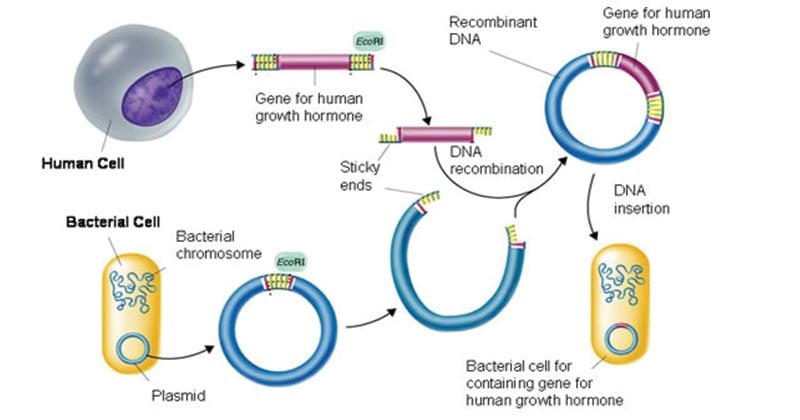- The production of exact copies of a particular gene or DNA sequence using genetic engineering techniques is called gene cloning.
- The term “gene cloning,” “DNA cloning,” “molecular cloning,” and “recombinant DNA technology” all refer to same technique.
- When DNA is extracted from an organism, all its genes are obtained. In gene (DNA) cloning a particular gene is copied forming “clones”.
- Cloning is one method used for isolation and amplification of gene of interest.
DNA cloning can be achieved by two different methods:
- Cell based DNA cloning
- Cell-free DNA cloning (PCR)
Interesting Science Videos
Requirements for Gene Cloning (Cell-based)
- DNA fragment containing the desired genes to be cloned.
- Restriction enzymes and ligase enzymes.
- Vectors – to carry, maintain and replicate cloned gene in host cell.
- Host cell– in which recombinant DNA can replicate.
Principle of Gene Cloning
A fragment of DNA, containing the gene to be cloned, is inserted into a suitable vector, to produce a recombinant DNA molecule. The vector acts as a vehicle that transports the gene into a host cell usually a bacterium, although other types of living cell can be used. Within the host cell the vector multiplies, producing numerous identical copies not only of itself but also of the gene that it carries. When the host cell divides, copies of the recombinant DNA molecule are passed to the progeny and further vector replication takes place. After a large number of cell divisions, a colony, or clone, of identical host cells is produced. Each cell in the clone contains one or more copies of the recombinant DNA molecule; the gene carried by the recombinant molecule is now said to be cloned.
Steps in Gene Cloning
The basic 7 steps involved in gene cloning are:
- Isolation of DNA [gene of interest] fragments to be cloned.
- Insertion of isolated DNA into a suitable vector to form recombinant DNA.
- Introduction of recombinant DNA into a suitable organism known as host.
- Selection of transformed host cells and identification of the clone containing the gene of interest.
- Multiplication/Expression of the introduced Gene in the host.
- Isolation of multiple gene copies/Protein expressed by the gene.
- Purification of the isolated gene copy/protein

A. Isolation of the DNA fragment or gene
- The target DNA or gene to be cloned must be first isolated. A gene of interest is a fragment of gene whose product (a protein, enzyme or a hormone) interests us. For example, gene encoding for the hormone insulin.
- The desired gene may be isolated by using restriction endonuclease (RE) enzyme, which cut DNA at specific recognition nucleotide sequences known as restriction sites towards the inner region (hence endonuclease) producing blunt or sticky ends.
- Sometimes, reverse transcriptase enzyme may also be used which synthesizes complementary DNA strand of the desired gene using its mRNA.
B. Selection of suitable cloning vector
- The vector is a carrier molecule which can carry the gene of interest (GI) into a host, replicate there along with the GI making its multiple copies.
- The cloning vectors are limited to the size of insert that they can carry. Depending on the size and the application of the insert the suitable vector is selected.
- The different types of vectors available for cloning are plasmids, bacteriophages, bacterial artificial chromosomes (BACs), yeast artificial chromosomes (YACs) and mammalian artificial chromosomes (MACs).
- However, the most commonly used cloning vectors include plasmids and bacteriophages (phage λ) beside all the other available vectors.
C. Essential Characteristics of Cloning Vectors
All cloning vectors are carrier DNA molecules. These carrier molecules should have few common features in general such as:
- It must be self-replicating inside host cell.
- It must possess a unique restriction site for RE enzymes.
- Introduction of donor DNA fragment must not interfere with replication property of the vector.
- It must possess some marker gene such that it can be used for later identification of recombinant cell (usually an antibiotic resistance gene that is absent in the host cell).
- They should be easily isolated from host cell.
D. Formation of Recombinant DNA
- The plasmid vector is cut open by the same RE enzyme used for isolation of donor DNA fragment.
- The mixture of donor DNA fragment and plasmid vector are mixed together.
- In the presence of DNA ligase, base pairing of donor DNA fragment and plasmid vector occurs.
- The resulting DNA molecule is a hybrid of two DNA molecules – the GI and the vector. In the terminology of genetics this intermixing of different DNA strands is called recombination.
- Hence, this new hybrid DNA molecule is also called a recombinant DNA molecule and the technology is referred to as the recombinant DNA technology.
E. Transformation of recombinant vector into suitable host
- The recombinant vector is transformed into suitable host cell mostly, a bacterial cell.
- This is done either for one or both of the following reasons:
- To replicate the recombinant DNA molecule in order to get the multiple copies of the GI.
- To allow the expression of the GI such that it produces its needed protein product.
- Some bacteria are naturally transformable; they take up the recombinant vector automatically.
For example: Bacillus, Haemophillus, Helicobacter pylori, which are naturally competent.
- Some other bacteria, on the other hand require the incorporation by artificial methods such as Ca++ ion treatment, electroporation, etc.
F. Isolation of Recombinant Cells
- The transformation process generates a mixed population of transformed and non-trans- formed host cells.
- The selection process involves filtering the transformed host cells only.
- For isolation of recombinant cell from non-recombinant cell, marker gene of plasmid vector is employed.
- For examples, PBR322 plasmid vector contains different marker gene (Ampicillin resistant gene and Tetracycline resistant gene. When pst1 RE is used it knock out Ampicillin resistant gene from the plasmid, so that the recombinant cell become sensitive to Ampicillin.
G. Multiplication of Selected Host Cells
- Once transformed host cells are separated by the screening process; becomes necessary to provide them optimum parameters to grow and multiply.
- In this step the transformed host cells are introduced into fresh culture media .
- At this stage the host cells divide and re-divide along with the replication of the recombinant DNA carried by them.
- If the aim is obtaining numerous copies of GI, then simply replication of the host cell is allowed. But for obtaining the product of interest, favourable conditions must be provided such that the GI in the vector expresses the product of interest.
H. Isolation and Purification of the Product
- The next step involves isolation of the multiplied GI attached with the vector or of the protein encoded by it.
- This is followed by purification of the isolated gene copy/protein.

Applications of Gene Cloning
- A particular gene can be isolated and its nucleotide sequence determined
- Control sequences of DNA can be identified & analyzed
- Protein/enzyme/RNA function can be investigated
- Mutations can be identified, e.g. gene defects related to specific diseases Organisms can be ‘engineered’ for specific purposes, e.g. insulin production, insect resistance, etc.
References
- http://www.biotechnologynotes.com/gene-cloning/7-main-steps-involved-in-gene-cloning/231
- http://www.unc.edu/depts/our/hhmi/hhmi-ft_learning_modules/proteinsmodule/cloning/process.html
- https://nptel.ac.in/courses/102103017/pdf/lecture%2035.pdf
- https://www.kau.edu.sa/Files/0012891/Files/65467_gene%20cloning.pdf
- https://www.tcd.ie/Biology_Teaching_Centre/assets/pdf/by1101/jfby1101/jfby1101-lecture11v2-2013-bw.pdf
- https://www.cheric.org/files/education/cyberlecture/e200402/e200402-301.pdf
- https://eclass.upatras.gr/modules/document/file.php/BIO276/Gene%20Cloning%20%26%20DNA%20Analysis.pdf
- http://www.onlinebiologynotes.com/gene-cloning-steps-involved-gene-cloning/

These are wonderful! Please make printable for hard-copy reference!
This is great
This is Fantastic
thanks for this huge information about gene cloning ,
so I would like to ask you what is the disadvantage of gene cloning
Nice notes